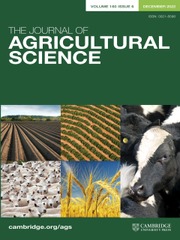Article contents
Response of Mediterranean grassland to phosphate and stocking rates: biomass production and botanical composition
Published online by Cambridge University Press: 27 March 2009
Summary
Three rates of phosphate (0, 25, and 60 kg/ha P2O5) were applied to phosphorus-deficient native grassland at Tel Hadya, in northern Syria, and biomass productivity, botanical composition and number of legume seeds in the soil were monitored for five seasons (1984/85–1988/89). The experiment was grazed at low (0·8 sheep/ha per year) and high (1·7 sheep/ha per year) stocking rates from the second to the fourth seasons of the experiment; in the fifth season, the low and high stocking rates were increased to 1·1 and 2·3 sheep/ha per year, respectively. The experimental site was typical of native grassland within the cereal zone of west Asia, where cropping is not possible because of shallow, stony soils and steep slopes.
The results showed that annual applications of phosphorus, even as low as 25 kg P2O5/ha, alleviated the deficiency in soil P and resulted in improved pasture production, even in dry years. Legume production showed the greatest response to P, increasing by 0·3–3 times the production of the control treatments. By the fifth season, legume seed mass had increased threefold and number of seeds sixfold in the P-treated plots, compared with the first season, while in the control plots there was little change. Rain-use efficiency on the P-treated plots was more than double that of the controls by the fourth and fifth seasons.
Practical application of the results depends on whether (i) legumes are as frequent in native grasslands, as a whole, as they are at Tel Hadya, (ii) the P deficiency observed at Tel Hadya is widespread, and (iii) grazing of communally owned grasslands can be controlled. It is suggested that all three criteria will often be fulfilled and, therefore, that grassland productivity in west Asia could be substantially increased. Furthermore, the results suggest that above-ground cover and soil organic matter will also increase after P application, both of which will help to reduce soil erosion and thereby increase the sustainability of livestock production in west Asia.
Information
- Type
- Crops and Soils
- Information
- Copyright
- Copyright © Cambridge University Press 1991
References
REFERENCES
- 39
- Cited by

